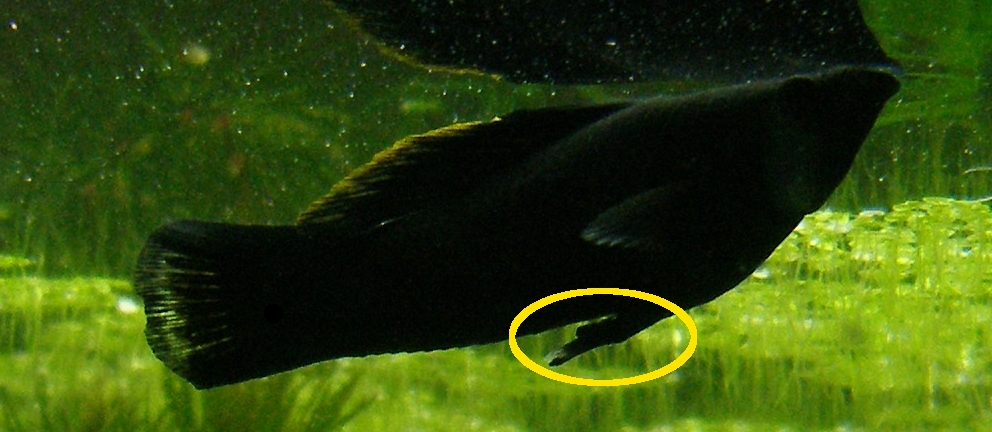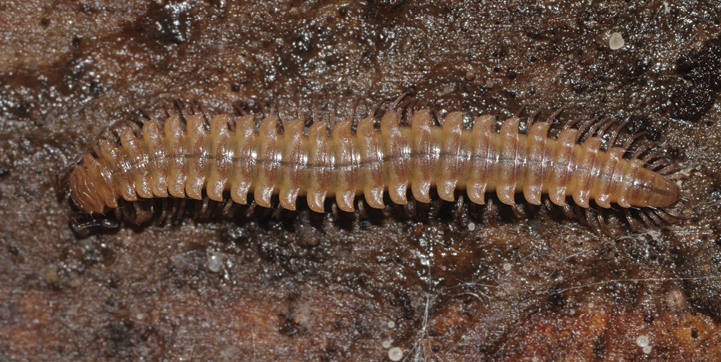|
Gonopod
Gonopods are specialized appendages of various arthropods used in reproduction or egg-laying. In males, they facilitate the transfer of sperm from male to female during mating, and thus are a type of intromittent organ. In crustaceans and millipedes, gonopods are modified arthropod leg, walking or swimming legs. Gonopods may be highly decorated with elaborate structures which may play roles in sperm competition, and can be used to differentiate and identify closely related species. Gonopods generally occur in one or more pairs, as opposed to the single (un-paired) reproductive organs such as the aedeagus of insects or the Opiliones penis, penis of harvestmen. Insects In insects, gonopods are appendages of the genital segment that may be used in insemination, or that comprise the egg-laying apparatus. Crustaceans In male decapoda, decapod crustaceans, gonopods are modified swimming appendages (pleopods). The anterior two pair of pleopods in males are modified for sperm transferr ... [...More Info...] [...Related Items...] OR: [Wikipedia] [Google] [Baidu] |
Millipedes
Millipedes (originating from the Latin , "thousand", and , "foot") are a group of arthropods that are characterised by having two pairs of jointed legs on most body segments; they are known scientifically as the class Diplopoda, the name derived from this feature. Each double-legged segment is a result of two single segments fused together. Most millipedes have very elongated cylindrical or flattened bodies with more than 20 segments, while pill millipedes are shorter and can roll into a tight ball. Although the name "millipede" derives from Latin for "thousand feet", no species was known to have 1,000 or more until the discovery in 2020 of '' Eumillipes persephone'', which can have over 1,300 legs. There are approximately 12,000 named species classified into 16 orders and around 140 families, making Diplopoda the largest class of myriapods, an arthropod group which also includes centipedes and other multi-legged creatures. Most millipedes are slow-moving detritivores, eating ... [...More Info...] [...Related Items...] OR: [Wikipedia] [Google] [Baidu] |
Gonopore
A gonopore, sometimes called a gonadopore, is a genital pore in many invertebrates. Hexapods, including insects, have a single common gonopore, except mayflies, which have a pair of gonopores. More specifically, in the unmodified female, it is the opening of the common oviduct, and in the male, it is the opening of the ejaculatory duct. The position of the gonopore varies considerably between groups, but is generally constant within groups, allowing its position to be used as a "segmental marker". In Malacostraca, it is on the sixth thoracic segment; in Symphyla, it is on the fourth trunk segment; in arachnids, it is on the second segment of the opisthosoma. In insects and centipedes, the gonopores are close to the animal's tail, while in millipede Millipedes (originating from the Latin , "thousand", and , "foot") are a group of arthropods that are characterised by having two pairs of jointed legs on most body segments; they are known scientifically as the class Dipl ... [...More Info...] [...Related Items...] OR: [Wikipedia] [Google] [Baidu] |
Intromittent Organ
An intromittent organ is any external organ of a male organism that is specialized to deliver sperm during copulation. Intromittent organs are found most often in terrestrial species, as most non-mammalian aquatic species fertilize their eggs externally, although there are exceptions. For many species in the animal kingdom, the male intromittent organ is a hallmark characteristic of internal fertilization. Species with intromittent organs Invertebrates Molluscs Male cephalopods have a specialized arm, the hectocotylus, which is inserted into the female's mantle cavity to deliver a spermatophore during copulation. In some species, the hectocotylus breaks off inside the female's mantle cavity; in others, it can be used repeatedly to copulate with different females. Arachnids In spiders, the intromittent organs are the male pedipalps, even though these are not primarily sexual organs, but serve as indirect mating organs; in the male the pedipalps have hollow, clubbed tips, o ... [...More Info...] [...Related Items...] OR: [Wikipedia] [Google] [Baidu] |
Craspedosomatidea
Chordeumatida (from the Greek word for "sausage") is a large order (biology), order of millipedes containing more than 1,400 species. Also known as sausage millipedes, they are found nearly worldwide. Chordeumatida is the largest order in the Order (biology), superorder Nematophora, a group also known as spinning millipedes because their Telson, telsons feature spinnerets used to build nests of silk. These millipedes produce this silk to create chambers in which to molt or to lay their eggs. Description Chordeumatidans take on a wide variety of forms, including some that are cylindrical and others that are flat-backed. Most species have 26 to 32 body segments (including the telson) behind the head, with the number usually fixed within species. These millipedes range in length from 3.5 mm to 42 mm, although most species are 10 mm to 25 mm long. They are usually drab in color, ranging from various shades of brown to unpigmented, but some feature distinct patterns. Species in this ... [...More Info...] [...Related Items...] OR: [Wikipedia] [Google] [Baidu] |
Heterochordeumatidea
Chordeumatida (from the Greek word for "sausage") is a large order of millipedes containing more than 1,400 species. Also known as sausage millipedes, they are found nearly worldwide. Chordeumatida is the largest order in the superorder Nematophora, a group also known as spinning millipedes because their telsons feature spinnerets used to build nests of silk. These millipedes produce this silk to create chambers in which to molt or to lay their eggs. Description Chordeumatidans take on a wide variety of forms, including some that are cylindrical and others that are flat-backed. Most species have 26 to 32 body segments (including the telson) behind the head, with the number usually fixed within species. These millipedes range in length from 3.5 mm to 42 mm, although most species are 10 mm to 25 mm long. They are usually drab in color, ranging from various shades of brown to unpigmented, but some feature distinct patterns. Species in this order share a set of features that di ... [...More Info...] [...Related Items...] OR: [Wikipedia] [Google] [Baidu] |
Chordeumatida
Chordeumatida (from the Greek word for "sausage") is a large order of millipedes containing more than 1,400 species. Also known as sausage millipedes, they are found nearly worldwide. Chordeumatida is the largest order in the superorder Nematophora, a group also known as spinning millipedes because their telsons feature spinnerets used to build nests of silk. These millipedes produce this silk to create chambers in which to molt or to lay their eggs. Description Chordeumatidans take on a wide variety of forms, including some that are cylindrical and others that are flat-backed. Most species have 26 to 32 body segments (including the telson) behind the head, with the number usually fixed within species. These millipedes range in length from 3.5 mm to 42 mm, although most species are 10 mm to 25 mm long. They are usually drab in color, ranging from various shades of brown to unpigmented, but some feature distinct patterns. Species in this order share a set of features that dist ... [...More Info...] [...Related Items...] OR: [Wikipedia] [Google] [Baidu] |
Striariidea
Chordeumatida (from the Greek word for "sausage") is a large order of millipedes containing more than 1,400 species. Also known as sausage millipedes, they are found nearly worldwide. Chordeumatida is the largest order in the superorder Nematophora, a group also known as spinning millipedes because their telsons feature spinnerets used to build nests of silk. These millipedes produce this silk to create chambers in which to molt or to lay their eggs. Description Chordeumatidans take on a wide variety of forms, including some that are cylindrical and others that are flat-backed. Most species have 26 to 32 body segments (including the telson) behind the head, with the number usually fixed within species. These millipedes range in length from 3.5 mm to 42 mm, although most species are 10 mm to 25 mm long. They are usually drab in color, ranging from various shades of brown to unpigmented, but some feature distinct patterns. Species in this order share a set of features that di ... [...More Info...] [...Related Items...] OR: [Wikipedia] [Google] [Baidu] |
Aedeagus
An aedeagus ( or aedeagi) is a reproductive organ of male arthropods through which they secrete sperm from the testes during copulation (zoology), copulation with a female. It can be thought of as the insect equivalent of a mammal's penis, though the comparison is fairly loose given the greater complexity of insect reproduction. The term is derived . The aedeagus is part of the male's abdomen, which is the hindmost of the three major body sections of an insect. The pair of testes of the insect are connected to the aedeagus through the genital Duct (anatomy), ducts. The aedeagus is part of the male insect's phallus, a complex and often species-specific arrangement of more or less sclerotized (hardened) flaps and hooks which also includes in some species the valvae (clasper), which are paired organs which help the male hold on to the female during copulation. During copulation, the aedeagus connects with the ovipore of a female. The aedeagus can be quite pronounced or ''de minim ... [...More Info...] [...Related Items...] OR: [Wikipedia] [Google] [Baidu] |
Glomeridesmida
Glomeridesmida is an order of millipedes in the infraclass Pentazonia containing two families ( Glomeridesmidae and Termitodesmidae) and at least 35 described species. Glomeridesmida is the only living order of the superorder Limacomorpha. Glomeridesmidans are also known as slug millipedes. Description Millipedes in this order are small, usually 4 to 8 mm (0.16 to 0.31 in.) long, with the largest reaching in length. These millipedes are somewhat flattened, and unlike other orders of Pentazonia, are unable to roll into a ball. Glomeridesmidans have antennae with seven segments but are blind and lack ommatidia. The penultimate pair of legs in males are modified into telopods. In most species, females feature a very long ovipositor. Most adult females in this order have 36 pairs of legs and 21 segments, counting 20 tergites plus the anal shield. Male specimens in this order are rare, unknown for all species in the family Termitodesmidae, and known for only a small numbe ... [...More Info...] [...Related Items...] OR: [Wikipedia] [Google] [Baidu] |
Arthropod
Arthropods ( ) are invertebrates in the phylum Arthropoda. They possess an arthropod exoskeleton, exoskeleton with a cuticle made of chitin, often Mineralization (biology), mineralised with calcium carbonate, a body with differentiated (Metamerism (biology), metameric) Segmentation (biology), segments, and paired jointed appendages. In order to keep growing, they must go through stages of moulting, a process by which they shed their exoskeleton to reveal a new one. They form an extremely diverse group of up to ten million species. Haemolymph is the analogue of blood for most arthropods. An arthropod has an open circulatory system, with a body cavity called a haemocoel through which haemolymph circulates to the interior Organ (anatomy), organs. Like their exteriors, the internal organs of arthropods are generally built of repeated segments. They have ladder-like nervous systems, with paired Anatomical terms of location#Dorsal and ventral, ventral Ventral nerve cord, nerve cord ... [...More Info...] [...Related Items...] OR: [Wikipedia] [Google] [Baidu] |









